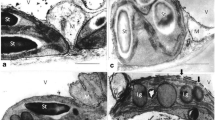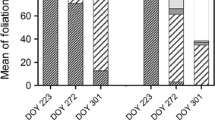Abstract
Parameters of sugar beet (Beta vulgaris L.) leaf senescence were investigated in the stage of vegetative growth in plants grown at normal nitrate level (N) or under its deficiency (DefN). Accelerated senescence was initiated by the 41-h-long exposure of leaf discs on the surface of water with alternating darkness and light. In plants grown at DefN, the number of leaves and their average area decreased; after the incubation of the discs from such leaves on water, the content of soluble carbohydrates (sCarb) and especially of glucose sharply increased as compared with normal level of nitrate (N), whereas the content of soluble protein (sProt) and Rubisco activity considerably decreased, which is characteristic of the negative hexokinase (HXK1) effect of glucose. The rate of a decrease in the content of sProt in the course of leaf senescence calculated for the leaf of each strorey was lower than the rate of a decrease in RuBisCO activity. A decrease in the content of sProt and RuBisCO activity in all the storeys of leaves grown at joint action of nitrate deficit (DefN) and incubation on water was on the average greater than in each of these treatments separately but less than the sum of these effects. The imperfection of the putative mechanism of signal transduction at DefN and excess glucose and their interaction in senescent sugar beet leaves is discussed as well as the opportunity to use the ratio between sCarb and sProt for the evaluation of the manifestation of the negative hexokinase effect of glucose.
Similar content being viewed by others
Abbreviations
- DefN:
-
nitrate deficiency
- DefNwater :
-
DefN after disc incubation on water
- N:
-
normal nitrate level
- Nwater :
-
N after disc incubation on water
- sCarb:
-
soluble carbohydrates
- sProt:
-
soluble protein
References
Nitrate: nutrient and signal for plant growth, Plant Cell, 1995, vol. 7, pp. 859–868.
Price, J., Laxmi, A., Martin, S.K.St., and Jang, J.Ch., Global transcription profiling reveals multiple sugar signal transduction mechanisms in Arabidopsis, Plant Cell, 2004, vol. 16, pp. 2128–2150.
Raghuram, N., Pathak, R.R., and Sharma, Pr., Signaling and molecular aspects of N-use-efficiency in higher plants, Biotechnological Approaches to Improve Nitrogen Use Efficiency in Plants, Singh, R.P. and Jaiwal, P.R., Eds., Houston, USA: Studium Press LLC, 2006, pp. 19–40.
Nunes-Nesi, A., Fernie, A.R., and Stitt, M., Metabolic and signaling aspects underpinning the regulation of plant carbon nitrogen interactions, Mol. Plant, 2010, vol. 3, pp. 973–996.
Semenenko, V.E., Mechanisms of photosynthesis regulation and adaptive properties of chloroplasts, Fiziologiya fotosinteza (Physiology of Photosynthesis), Nichiporovich, A.A., Ed., Moscow: Nauka, 1982.
Van Oosten, J.J., Wilkins, D., and Besford, R.T., Regulation of the expression of photosynthesis nuclear genes by CO2 is mimicked by regulation by carbohydrates, a mechanism for the acclimation of photosynthesis to high CO2, Plant Cell Environ., 1994, vol. 17, pp. 913–923.
Jang, J.C. and Sheen, J., Sugar sensing in higher plants, Plant Cell, 1994, vol. 6, pp. 1665–1679.
Kovtun, Y. and Daie, J., End-product control mechanism in culture-grown sugar beet plants. Molecular and physiological evidence on accelerated leaf development and enhanced gene expression, Plant Physiol., 1995, vol. 108, pp. 1647–1656.
Koch, K.E., Carbohydrate-modulated gene expression in plants, Annu. Rev. Plant Physiol. Plant Mol. Biol., 1996, vol. 47, pp. 509–540.
Jang, J.Ch., Leon, P., Zhou, L., and Sheen, J., Hexokinase as a sugar sensor in higher plants, Plant Cell, 1997, vol. 9, pp. 5–9.
Romanova, A.K., Physiological and biochemical aspects and molecular mechanisms of plant adaptation to the elevated concentration of atmospheric CO2, Russ. J. Plant Physiol., 2005, vol. 52, pp. 112–126.
Chiou, T.J. and Bush, D.R., Sucrose is the signal molecule in assimilate partitioning, Proc. Natl. Acad. Sci. USA, 1998, vol. 95, pp. 4784–4788.
Ramon, M., Rolland, F., and Sheen, J., Sugar sensing and signaling, Arabidopsis Book, Rockville (MD): Amer. Soc. Plant Physiol., 2008, vol. 6: e0117, doi 10.1199.tab.0117
Rolland, F., Moore, B., and Sheen, J., Sugar sensing in plants, Plant Cell, 2002, vol. 14,suppl., pp. S185–S205.
Jeon, J.S., Role of rice hexokinases OHXK5 and OHXK6 as glucose sensors, Plant Physiol., 2009, vol. 149, pp. 745–759.
Claeyssen, É. and Rivoal, J., Isozymes of plant hexokinase: occurrence, properties, and functions, Phytochemistry, 2007, vol. 68, pp. 709–731.
Balasubramanian, R., Karve, A., Kandasamy, M., Mesgher, R.S., and Moore, B., A role of F-actin in hexokinase-mediated signaling, Plant Physiol., 2007, vol. 145, pp. 1423–1434.
Feller, U. and Fischer, A., Nitrogen metabolism in senescing leaves, Crit. Rev. Plant Sci., 1994, vol. 13, pp. 241–273.
Ludewig, F. and Sonnenwald, U., High-CO2-mediated down regulation of photosynthetic gene transcripts is caused by accelerated leaf senescence rather than sugar accumulation, FEBS Lett., 2000, vol. 479, pp. 19–24.
Milford, G.F.J. and Pearman, I., The relationship between photosynthesis and concentrations of carbohydrates in the leaves of sugar beet, Photosynthetica, 1975, vol. 9, pp. 78–83.
Novichkova, N.S., Romanova, A.K., Ignat’ev, A.R., Mudrik, V.A., Permyakov, S.E., and Ivanov, B.N., Effect of surplus glucose on physiological and biochemical characteristics of sugar beet leaves in relation to the age of the leaf and the whole plant, Russ. J. Plant Physiol., 2008, vol. 55, pp. 201–210.
Martin, T., Oswald, O., and Graham, I., Arabidopsis seedling growth, storage lipid mobilization, and photosynthetic gene expression are regulated by carbon: nitrogen availability, Plant Physiol., 2002, vol. 128, pp. 472–481.
Romanova, A.K., Semenova, G.A., Novichkova, N.S., Ignat’ev, A.R., Mudrik, V.A., and Ivanov, B.N., Physiological, biochemical, and fluorescence parameters of senescing sugar beet leaves in the vegetative phase of growth, Russ. J. Plant Physiol., 2011, vol. 58, pp. 271–282.
Lowry, O.H., Rosebrough, N.J., Farr, A.L., and Randall, R.J., Protein measurement with the Folin phenol reagent, J. Biol. Chem., 1951, vol. 193, pp. 265–275.
Noodén, L.D., The phenomena of senescence and aging, Senescence and Aging in Plants, Noodén, L.D. and Leopold, A.C., Eds., San Diego (CA): Academic, 1988, pp. 1–50.
Lalonde, S., Boles, E., Hellmann, Y., Barker, L., Patrick, J.W., Frommer, W.B., and Ward, J.M., The dual function of sugar carriers, Plant Cell, 1999, vol. 11, pp. 707–726.
Simova-Stoilova, L., Demirevska-Kepova, K., and Stoyanova, Z., Ribulose-1,5-bisphosphate carboxylase/oxygenase specific proteolysis in barley chloroplasts during induced dark senescence, Photosynthetica, 2002, vol. 40, pp. 561–566.
Author information
Authors and Affiliations
Corresponding author
Additional information
Original Russian Text © A.K. Romanova, N.S. Novichkova, A.R. Ignat’ev, I.A. Naidov, V.A. Polyakova, 2014, published in Fiziologiya Rastenii, 2014, Vol. 61, No. 4, pp. 536–545.
Rights and permissions
About this article
Cite this article
Romanova, A.K., Novichkova, N.S., Ignat’ev, A.R. et al. Variability of key biochemical parameters in senescent leaves of sugar beet at nitrate deficiency and surplus accumulation of glucose. Russ J Plant Physiol 61, 503–511 (2014). https://doi.org/10.1134/S1021443714040153
Received:
Published:
Issue Date:
DOI: https://doi.org/10.1134/S1021443714040153




